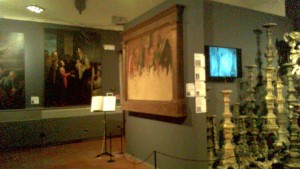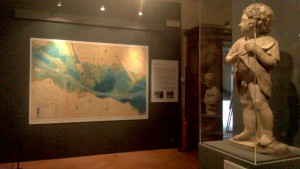

Firenze, Palazzo Medici Riccardi, 1 dicembre 2016 – 26 marzo 2017
Di Caterina Zaru (Università degli Studi di Firenze)
In occasione della ricorrenza della tragica alluvione che il 4 novembre 1966 colpì Firenze, devastando il Patrimonio artistico e architettonico soprattutto della città, ma anche del territorio limitrofo, si è inaugurata la mostra Firenze 1966 – 2016. La bellezza salvata, curata da Cristina Acidini e Elena Capretti e visitabile fino al 26 marzo 2017.
L’esposizione di 150 pezzi, fra dipinti, sculture, libri, documenti, oggetti d’arte applicata, strumenti musicali e scientifici, vuol mettere l’accento su quella che fu la risposta dei fiorentini e del mondo intero alla tragedia. Così, protagonisti principali di tutta la mostra sono proprio i risultati tecnici e le innovazioni scientifiche ottenuti nel campo del restauro e che hanno permesso, e permettono ancora, di salvare le opere, i manufatti e i monumenti dalla forza distruttrice dell’acqua, del fango e della nafta.
In una mostra che risulta molto ben curata in ogni sua parte, non è lasciata al caso neanche la scelta della sua sede: Palazzo Medici Riccardi, che al momento dell’alluvione era sede del Museo Mediceo, uno dei luoghi di Firenze tra i più colpiti dalla catastrofe. E proprio a proposito dei luoghi colpiti, particolarmente interessante è la riproduzione della bella pianta di Firenze, il cui originale è conservato presso l’Istituto Geografico Militare di Firenze. Essa esposta nella prima sala indica chiaramente i vari livelli raggiunti dall’acqua dopo l’esondazione dell’Arno. Da sottolineare come particolarmente positiva, è anche la scelta di dedicare intere sale espositive a quei luoghi, un po’ meno celebri rispetto alla Biblioteca Nazionale o al complesso di Santa Croce, ma che ugualmente subirono ingenti danni, come la Sinagoga e il Museo Archeologico, il Museo Bardini e il Museo della Fondazione Horne. Con lo stesso principio si è deciso di esporre anche quei nuclei collezionistici che da poco tempo sono entrati a far parte del Patrimonio culturale, e che di solito, quando si parla di alluvione, non si prendono neanche in considerazione. Stiamo parlando degli strumenti scientifici e musicali, che, come spiega il video che ne accompagna l’esposizione, sono tra i pezzi più difficili da restaurare, perché essenziale è ripristinarne il corretto funzionamento. Altri “sconosciuti” al grande pubblico, sono gli “ultimi”, così chiamati dagli stessi curatori, e cioè quelle opere che ancora attendono di essere restaurate e che rischiano addirittura di essere dimenticate, se il processo di recupero, giunto ormai ad altissimi livelli tecnici, non si appresta a concludersi anche per esse. L’intento di mostrarle in questa sede sembra essere, quindi, quello di incoraggiare adeguati finanziamenti e interventi.
Di notevole interesse sono le fotografie storiche riprodotte nei pannelli esplicativi e che ben documentano i danni e gli interventi di recupero. Tutto l’apparato didascalico risulta ben concepito ai fini di rendere più chiaro l’intento generale della mostra e fornire utili strumenti alla comprensione di quanto esposto. Peccato che il tutto sia stato realizzato nella sola lingua italiana. La mancanza di un’apertura a livello internazionale in questo senso, non rende merito alla qualità dell’intera iniziativa. Inoltre, stona ancora di più se pensiamo a quanta risonanza, a livello internazionale appunto, l’alluvione ebbe a suo tempo, con volontari che, da tutto il mondo, arrivarono a Firenze per dare il proprio contributo nel mettere in salvo una grande fetta del Patrimonio dell’Umanità che rischiava di andare distrutta.
Florence 1966-2016: The Rescued Beauty
Translation by Rachyl Grussing (Istituto Lorenzo de’ Medici)
For the occasion of the anniversary of the tragic flood that hit Florence on the 4th of November 1966, devastating the artistic and cultural heritage of the city especially, and also the surrounding area, the inauguration of the exhibition Florence 1966-2016, The Rescued Beauty, curated by Cristina Acidini and Elena Capretti and is available until March 26, 2017.
The exhibition is 150 pieces between paintings, sculptures, books, documents, and objects of applied art, scientific and musical instruments, and wants to put the emphasis on what was the Florentines and the whole world’s response to the tragedy. Thus, the principal protagonist of the entire show is the technical result and scientific innovation obtained in the field of restoration and which allowed, and still allows, the salvation of works from the destructive force of the water, mud, and the oil.
In this show the result is very well maintained in its entirety, nothing left to chance, even the choice of the headquarters: Palazzo Medici Riccardi, that at the moment of the flood was the headquarters for the Medici Museum, which was one of the principle areas of destruction. And about the affected areas, of particular interest is the reproduction of the beautiful plant of Florence, the original of which is kept in the Institute of Military Geography of Florence. Exhibited clearly in the first room is the various levels reached by the Arno after the flooding. A choice which is positively emphasized is the choice to dedicate an entire room to the less famous places than the National Library or the complex of Santa Croce, but that equally suffered considerable damages, like the Synagogue, the Archaeology Museum, the Bardini Museum and the Horne Museum. By that same principle it was decided to exhibit the collectable nuclei that have only recently entered into the cultural heritage, and that usually, when there is flooding, is not taken into consideration at all. We are talking about scientific and musical instruments, that, which as is explained in the accompanying video, are among the most difficult pieces to restore, because it is essential to restore its correct function. Other “unknowns” to the general public are the “last”, called so by the curators, are namely the works still waiting to be restored and that even risk being forgotten, through the process of recovery, but it is not about to be completed for them. The intent of the show seems to be, therefore, to encourage adequate funding and interventions.
Of particular interest are the historical photographs reproduced on explanatory panels and the well-documented damages and recovery interventions. All the didactic elements are well thought out in order to clarify the general aim and provide useful tools for understanding the exhibition. It is too bad that the show has been realized in Italian only. The lack of an opening into the international level in this sense, does not do justice to the entire initiative. Furthermore, it is even more out of place if we think of how much resonance, at just the international level, the flood had at the time, with volunteers from around the world, arrived in Florence to make its own contribution to rescue a large swath of world heritage that risked being destroyed.